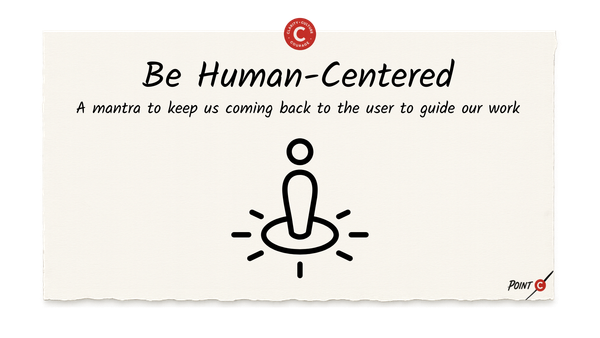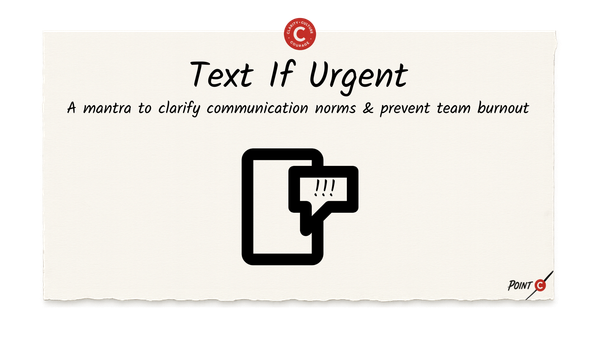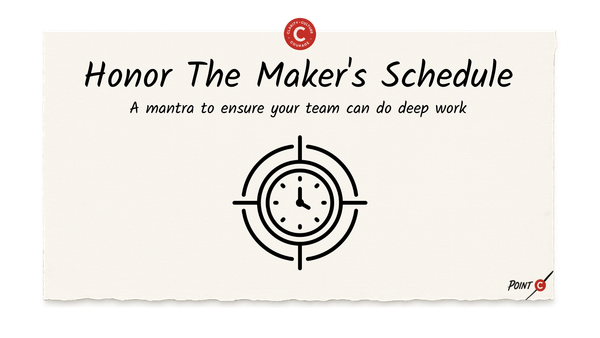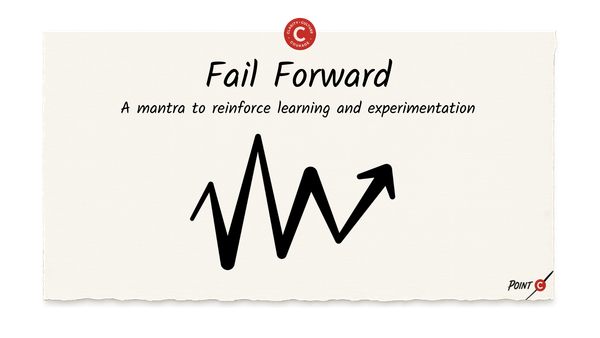The Venture Story
A way to turn your strategy into a concrete, comprehensive, & compelling narrative with 3 Acts, 9 Scenes, and 54 Beats
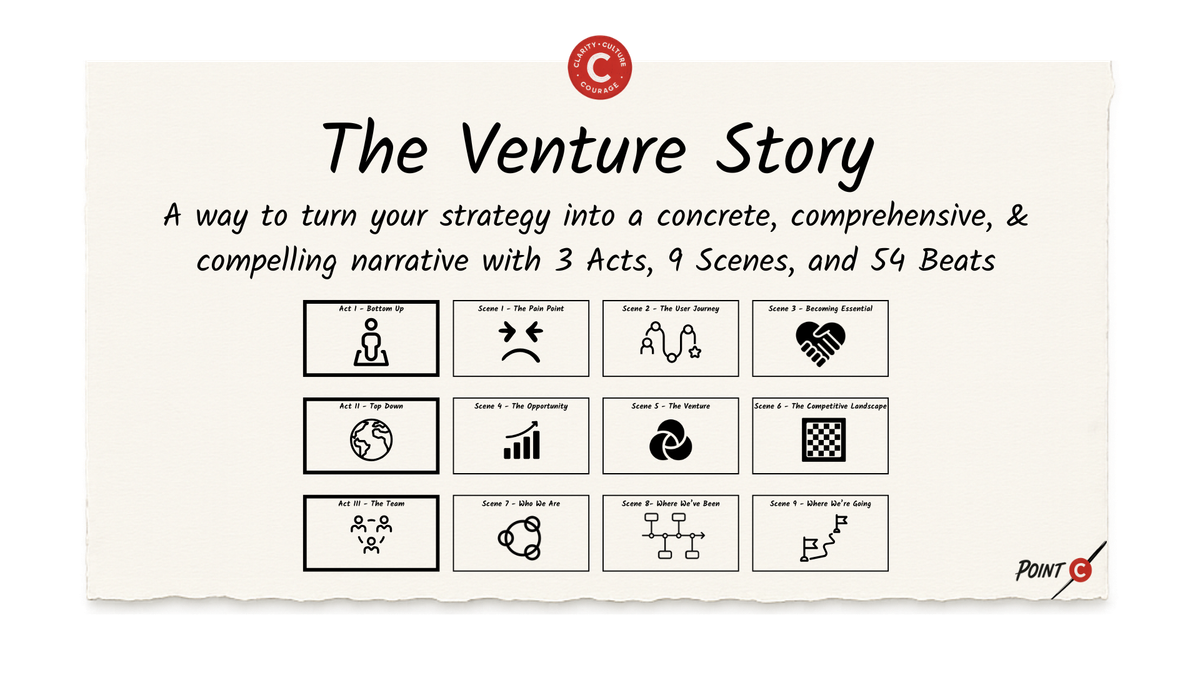
Welcome back to The Idea Bucket.
In the last three issues, we covered foundational tools for preparing your team to design a compelling venture:
- The Selection Stack — to align on what success looks like.
- The Rubric — to uphold high standards across teams.
- The Design Review — to create safe feedback loops that sharpen strategy.
But how do you actually prepare a strategy to be tested at a Design Review? Ventures are complicated. Can you elegantly bring all the variables together? Is that even possible in 10 minutes or less?
Why, yes. It is.
Introducing: The Venture Story
At some point—whether you’re raising capital, aligning your board, or leading your team through change—you need to tell the full story of your venture.
And by "venture," I don’t just mean startups. I mean any initiative where strategy must become story, whether it be a new product launch to an external audience or a transformation initiative for an internal audience. It works for start-ups and 100-year old institutions, and for-profit and not-for-profit tax statuses.
Regardless, before you tell the story to others, you have to tell it to yourself:
- To understand what you’re building.
- To see what’s clear—and what’s not.
- To surface holes in logic, gaps in alignment, or missing next steps.
Most leaders are surprised by what they uncover. Not because they’re unprepared, but because ventures are complex. Coherence doesn't come on the first try—it emerges through intentional iteration.
That’s why I created a simple but powerful tool to help you bring all the moving parts together—and start iterating before its too late.
What Is The Venture Story?
The Venture Story is a way to turn your strategy into a concrete, comprehensive, and compelling narrative with 3 Acts, 9 Scenes, and 54 Beats. It’s a prototype pitch deck designed to force clarity—before polish.
Slides become beats in a story. Each one should feel like a single click of a metronome. One concise thought. One visual. Then next. Click. Click. Click.
If you’re pausing to explain a slide, you're doing it wrong.
This week’s post introduces the 3 Acts and 9 Scenes of The Venture Story. Over the next few issues, we’ll go deeper into the 54 Beats — the specific narrative steps that bring each scene to life.

Act I: Bottom-Up
A way to ground your pitch in a concrete, comprehensive user narrative.
In Act I, we start concrete and focus our audience on a specific user in a specific context with a specific problem, before, during, and after we solve their pain point with a specific solution. We are leveraging the power of character-driven narrative and, in Act I, our user is the character .
(Note: In Act I, we are pitching the vision for the world we are going to create for the user, not necessarily the reality of today. This is a concrete future vision. In Act III, we square that vision with the reality of the moment and how we will get there.)
Scene 1: The Pain Point
Take us into the key moment in your user's life. What are they aspiring to do and what is getting in their way? What other options have they tried and how are they falling short? End this scene with the key insight that your team has discovered through your research that others have missed.
Scene 2: The User Journey
Now, take us back to that key moment—but this time, it's different. Show how the user discovers your solution. Walk through a detailed demo of their first use. What’s the immediate payoff? What triggers them to return? How does a habit form over time? And, when the moment is right, how do you convert them from free to paid?
Scene 3: Becoming Essential
Now that we understand the core user experience, show how your offering becomes essential to your user over time—from the steady state behaviors that help retain users, to how they come to rely on you, to how they invest themselves in it over time, to how they share it with others. Ultimately, reveal the behavior and identity shift that occurs.

Act II: Top-Down
A way to tell the big picture story of your venture and the landscape.
With the bottom-up specificity of Act I, we have now earned the right to zoom out and go abstract. In Act II, we tell the strategic story—where the world is going, what we’re building, and how we’ll win.
Scene 4: The Opportunity
Let’s zoom out from the user and see how many people have the same needs. Show the market and opportunity size. What trends are converging to make this a big opportunity two years from now? Finally, create a sense of urgency—why is now the time to act?
Scene 5: The Venture
Now we get into the unique details of your venture. Start by describing how you will reach your first customers through your pilot. Lay out the operational and technical details. Highlight the revenue and cost drivers in your business model. Map out the key stages of the funnel. Finally, show how the venture will scale if the pilot succeeds.
Scene 6: The Competitive Landscape
We’ve established that this space is worth pursuing—but we’re not the only ones here. Highlight key competitors and substitutes. Show how you’ll differentiate your offering and brand. (A 2x2 works magic here.) Outline the key forces shaping the industry. Identify any barriers that might prevent your entry. Then state the strategy you’ll deploy to build a sustainable competitive advantage over time. Finally, based on this analysis, summarize the key risks and key success factors—where you’ll focus your limited time and resources.
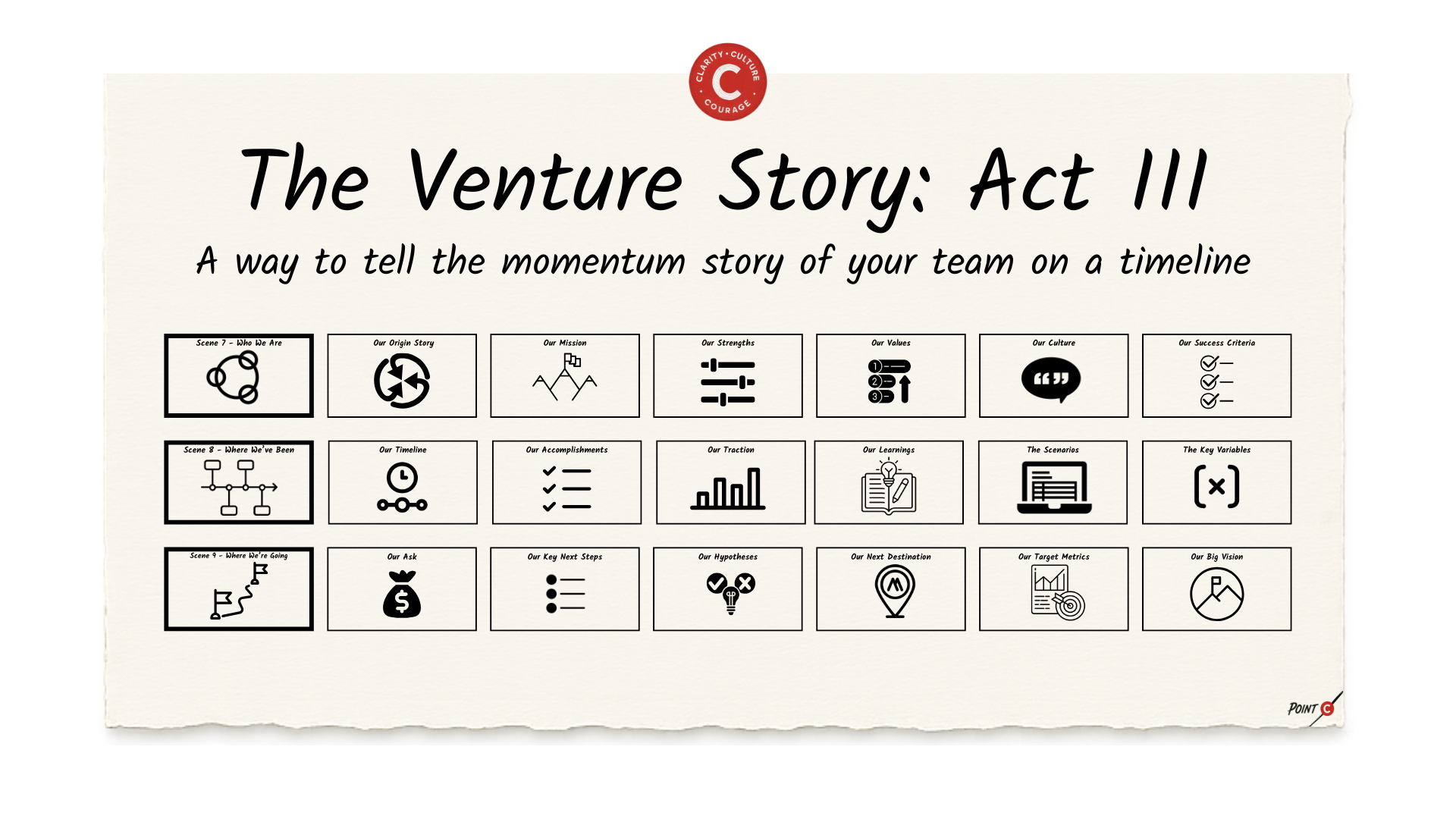
Act III: The Team
A way to tell the momentum story of your team on a timeline.
We told the bottom-up user story in Act I. We zoomed out to the venture story in Act II. Now it’s time for the final character-driven narrative: the story of your team. This should scream momentum, momentum, momentum.
Scene 7: Who We Are
Your audience has heard about the opportunity. Now it’s time to prove you’re the team to do it. What’s your mission? Why are your backgrounds the right fit for this challenge? What assets can you leverage? What values, culture, and norms reinforce your strategy? How do you define success?
Scene 8: Where We’ve Been
Lay out your timeline. What have you done so far? What traction have you earned? What did you learn? This is also the moment to show you’ve modeled the most likely scenarios and know which variables matter most.
Scene 9: Where We’re Going
Now for the close. What resources are you asking for? What will you do with those resources? What risks will you reduce and what hypotheses will you prove?
Here is the key moment: You have to sell Point C - the concrete vision for your next destination 18–24 months from now. You are asking your stakeholders to buy a ticket to that. Will it appear to be a bridge to nowhere? Or is it clear that if you make it to that "next fundable lily pad" that you'll be set up to leap to your next major milestone?
Finally, reinforce the big long-term vision for your company and invite your stakeholders to join you on this journey.
Make it vivid. Make it inevitable.
The Power of The Venture Story
The Dance of Great Strategy
You might think you’re ready to pitch. You’ve got a product. Research. A team. A plan.
But until you put all the moving parts into a single, coherent story, you can’t see the full picture. Gaps hide in plain sight. Critical disconnects—between user behavior and business model, between differentiation and defensibility, between where you’re headed and what it unlocks—go unnoticed.
That’s why, inside my programs, we start with a ritual called Design Review Zero. In week two, teams pitch the full arc of their venture—before they’re ready. The point isn’t polish. It’s pressure testing. It’s to see what doesn’t yet fit. When you draft the story early, you reveal the work you still need to do.
The Venture Story isn’t just how you pitch—it’s how you plan. It helps you see what research you need to gather, what choices still need to be made, and how every part of your venture connects.
Great strategy isn’t static. It’s a dance. Everything affects everything else. The Venture Story lets you learn the choreography early—before missteps become expensive.
Story Is How We Make Sense of Complexity
Before I headed West to Silicon Valley, I worked on 17 documentary films with the co-founder of FRONTLINE. From him, I learned the secret to a great documentary: you don’t explain an expository topic—you tell the narrative of a specific person.
It's called Character-Driven Narrative and it's the magic storytellers use to take abstract, complex topics and turn them into simple, sticky stories.
When I entered the world of design-driven ventures, I realized this same principle applies. Your user and your team are the protagonists. Your venture is their journey. A good strategy must be understood. A great one must be felt.
In pitches, most entrepreneurs start—and stay—too abstract. They aim to impress with the size of the market or the scale of the vision. But they forget a core rule of storytelling:
You must earn the right to go abstract.
Start concrete. Anchor your audience in a shared reality. Then zoom out.
Leaders Must Be Storytellers
At some point, every leader must align others around their vision—whether it's their board, their team, or their customers.
And nothing aligns like story.
A well-told Venture Story earns trust, invites belief, and gives others language they can pass on. It transforms strategy from something written in a doc into something felt across a team. It makes strategy sticky.
That’s the real power of the Venture Story: It’s not just how you pitch. It’s how you build alignment.
And alignment is leadership.
Your Challenge This Week
Start your Venture Story with a gut check.
Download the first worksheet of The Venture Story Workbook — a one-page map of all 9 scenes and 54 beats across the 3 acts:
Step 1: Grab three markers — green, yellow, and red.
Print the worksheet. Circle each beat or slide title based on your current clarity:
- Green: I have this — validated with evidence, examples, or experience.
- Yellow: I sort of have it — it’s plausible, but still needs testing.
- Red: I don’t have this — it’s made up or totally missing.
Step 2: Pick one red-circled beat in Act I. Research, test, or validate that part of the story this week.
Your goal: Be prepared to start filling out the full Act I next week. Research what you can between now and then.
Share what you circled by emailing theideabucket@pointc.co — I'll give you a tip on how to tackle that red circle.
Next Week
We zoom in on Scene I: The Pain Point — the first scene of the first Act of the Venture Story. I’ll break down each beat and give you the exact Mad Libs and coaching prompts to help you write them.
In the following weeks, we’ll do the same for each of the 9 scene of The Venture Story. You’ll also see how to adapt the Venture Story to different contexts: external products vs. internal initiatives, start-ups vs. institutions, and for-profit vs. nonprofit ventures.
Until then — circle what’s real, highlight what’s missing, and start closing the gaps.
About This Newsletter
The Idea Bucket is a weekly newsletter and archive featuring one visual framework, supporting one act of leadership, that brings you one step closer to building a culture of innovation.
It’s written by Corey Ford — executive coach, strategic advisor, and founder of Point C, where he helps founders, CEOs, and executives clarify their visions, lead cultures of innovation, and navigate their next leadership chapters.
Want to give your teams an immersive learning experience on these concepts? Bring me in to run The Point C Training Camp at our company. Want 1:1 executive coaching on this framework or others? Book your first coaching session. It's on me.

